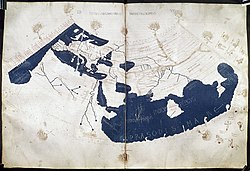Names of China
The names of China are expressed differently in different languages and different times. Some of these names come from ancient times, while others are from modern times. In Chinese, the name of China is Zhōngguó (中國/中国, "central country") in its national language, Standard Mandarin. China, while the name in English for the country, came from Portuguese in the 16th century. This became common usage in the West in the subsequent centuries.[2] It is believed to come from Middle Persian. Though some people thought it traced further back to Sanskrit. Some also thought that the ultimate source of the name China is the Chinese word "Qin" (Chinese: 秦), the name of the dynasty of China. However, others have different opinions. [3][4][5]
| China | |||||||||||||||||||||||||||||||||||||||||||||||||||||||||||
|---|---|---|---|---|---|---|---|---|---|---|---|---|---|---|---|---|---|---|---|---|---|---|---|---|---|---|---|---|---|---|---|---|---|---|---|---|---|---|---|---|---|---|---|---|---|---|---|---|---|---|---|---|---|---|---|---|---|---|---|
[[file: |frameless]] |frameless]]
| |||||||||||||||||||||||||||||||||||||||||||||||||||||||||||
| "China" in Simplified (top) and Traditional (bottom) Chinese characters | |||||||||||||||||||||||||||||||||||||||||||||||||||||||||||
| Chinese name | |||||||||||||||||||||||||||||||||||||||||||||||||||||||||||
| Traditional Chinese | 中國 | ||||||||||||||||||||||||||||||||||||||||||||||||||||||||||
| Simplified Chinese | 中国 | ||||||||||||||||||||||||||||||||||||||||||||||||||||||||||
| Hanyu Pinyin | Zhōngguó | ||||||||||||||||||||||||||||||||||||||||||||||||||||||||||
| Literal meaning | Middle or Central State[1] | ||||||||||||||||||||||||||||||||||||||||||||||||||||||||||
| |||||||||||||||||||||||||||||||||||||||||||||||||||||||||||
| Common name | |||||||||||||||||||||||||||||||||||||||||||||||||||||||||||
| Traditional Chinese | 中華 | ||||||||||||||||||||||||||||||||||||||||||||||||||||||||||
| Simplified Chinese | 中华 | ||||||||||||||||||||||||||||||||||||||||||||||||||||||||||
| |||||||||||||||||||||||||||||||||||||||||||||||||||||||||||
| Uyghur name | |||||||||||||||||||||||||||||||||||||||||||||||||||||||||||
| Uyghur | جۇڭگو
| ||||||||||||||||||||||||||||||||||||||||||||||||||||||||||
| |||||||||||||||||||||||||||||||||||||||||||||||||||||||||||
In addition to these names, names of China also include Zhōnghuá (中華/中华, "central beauty"), Huáxià (華夏/华夏, "beautiful grandness"), Shénzhōu (神州, "divine state") and Jiǔzhōu (九州, "nine states"). Hàn (漢/汉) and Táng (唐) . The People's Republic of China (Zhōnghuá Rénmín Gònghéguó) and Republic of China (Zhōnghuá Mínguó) are the official names for the two sovereign states now claiming sovereignty over the traditional area of China. "Mainland China" is used to refer to areas under the control of the PRC, usually not including Hong Kong and Macau. [6][7][8][9][10]
There are also names for China used around the world. "Cathay" from the Khitan language and "Tabgach" from Tuoba are examples.
List of derived terms
- Afrikaans: Sjina, spelling now obsolete and spelled as China (pronunciation is the same) (pronounced [ˈʃina])
- Albanian: Kinë (pronounced [kinə])
- Amharic: Chayna (from English)
- Armenian: Չինաստան (pronounced [t͡ʃʰinɑsˈtɑn])
- Assamese: চীন (pronounced [sin])
- Azeri: Çin (IPA: [tʃin])
- Basque: Txina (IPA: [tʃina])
- Bengali: চীন (pronounced [ˈtʃiːn])
- Burma: တရုတ် (pronounced: [θˈjəʊt])
- Catalan: Xina ([ˈ(t)ʃi.nə])
- Chinese: 支那 Zhīnà (obsolete and considered offensive due to historical Japanese usage; originated from early Chinese translations of Buddhist texts in Sanskrit)
- Chinese: 震旦 Zhèndàn transcription of the Sanskrit/Pali "Cīnasthāna" in the Buddhist texts.
- Czech: Čína (pronounced [ˈtʃiːna])
- Danish: Kina (pronounced [ˈkʰiːnɑ])
- Dutch: China ([ʃiːnɑ])
- English: China
- Esperanto: Ĉinujo or Ĉinio, or Ĥinujo (archaic)
- Estonian: Hiina (pronounced [hiːnɑ])
- Filipino: Tsina ([tʃina])
- Finnish: Kiina (pronounced [ˈkiːnɑ])
- French: Chine ([ʃin])
- Galician: China (pronounced [ˈtʃinɐ])
- Georgian: ჩინეთი (pronounced [tʃinɛtʰi])
- German: China ([ˈçiːna] and [ʃiːnɑ], in the southern part of the German-speaking area also [ˈkiːna])
- Greek: Κίνα (Kína) ([ˈcina])
- Gujarati: Cīn ચીન (IPA [ˈtʃin])
- Hindustani: Cīn चीन or چين (IPA [ˈtʃiːn])
- Hungarian: Kína ([ˈkiːnɒ])
- Icelandic: Kína ([cʰiːna])
- Indonesian: Cina ([tʃina])
- Interlingua: China
- Irish: An tSín ([ənˠ ˈtʲiːnʲ])
- Italian: Cina ([ˈtʃiːna])
- Japanese: Shina (支那) – considered offensive in China, now largely obsolete in Japan and avoided out of deference to China (the name Chūgoku [[Help:IPA/Japanese|[[[:Template:C-ja]]Template:C-jaTemplate:C-ja]]] is used instead); See Shina (word) and kotobagari.
- Javanese: ꦕꦶꦤ Cina (low speech level); ꦕꦶꦤ꧀ꦠꦼꦤ꧀ Cinten (high speech level)
- Kapampangan: Sina
- Khmer: ចិន ( [cən])
- Korean: Jina (지나; [t͡ɕinɐ])[source?]
- Latvian: Ķīna ([ˈciːna])
- Lithuanian: Kinija ([kʲɪnʲijaː])
- Macedonian: Кина (Kina) ([kinɐ])
- Malay: Cina ([tʃina])
- Malayalam: Cheenan/Cheenathi
- Maltese: Ċina ([ˈtʃiːna])
- Marathi: Cīn चीन (IPA [ˈtʃiːn])
- Nepali: Cīn चीन (IPA [ˈtsin])
- Norwegian: Kina ([ˈçìːnɑ])
- Pahlavi: Čīnī
- Persian: Chīn چين ([tʃin])
- Polish: Chiny ([ˈçinɨ])
- Portuguese: China ([ˈʃinɐ])
- Romanian: China ([ˈkina])
- Serbo-Croatian: Kina or Кина ([ˈkina])
- Sinhala: Chinaya චීනය
- Slovak: Čína ([ˈtʂiːna])
- Spanish: China ([ˈtʃina])
- Somali: Shiinaha
- Swedish: Kina ([ˈɕîːna])
- Tamil: Cīnam (சீனம்)
- Thai: จีน (RTGS: Chin [t͡ɕiːn])
- Tibetan: Rgya Nag (རྒྱ་ནག་)
- Turkish: Çin ([tʃin])
- Vietnamese: Chấn Đán (震旦) ([t͡ɕən ɗǎn] or Chi Na (支那) ([ci na]) (in Buddhist texts).
- Welsh: Tsieina ([ˈtʃəina])
- Yiddish: כינע Khine ([ʽxɪnə])
Names Of China Media
He zun rubbing and transcription; framed is the phrase 宅𢆶𠁩或 zhái zī zhōngguó "inhabit this central state". Same phrase in Traditional Chinese characters is 宅茲中國, and Simplified Chinese characters is 宅茲中国.
The brocade armband with the words "Five stars rising in the east, being a propitious sign for Zhongguo (中國)", made in the Han dynasty.
The Nestorian Stele 大秦景教流行中國碑 entitled "Stele to the propagation in Zhongguo (Chinese: 中國) of the luminous religion of Daqin (Roman Empire)", was erected in China in 781 during Tang dynasty.
The most important Korean document, Hunminjeongeum, dated 1446, where it compares Joseon's speech to that of Zhongguo (中國) (Middle Kingdom; China), which was during the reign of Ming dynasty at the time. Korean and other neighbouring societies have addressed the various regimes and dynasties on the Chinese mainland at differing times as the "Middle Kingdom".
"Middle Kingdom's Common Speech" (Medii Regni Communis Loquela, Zhongguo Guanhua, 中國官話), the frontispiece of an early Chinese grammar published by Étienne Fourmont in 1742
Chapter China (中國) of "The Manchurian, Mongolian and Han Chinese Trilingual Textbook" (滿蒙漢三語合璧教科書) published in Qing dynasty: "Our country China is located in East Asia... For 5000 years, culture flourished (in the land of China)... Since we are Chinese, how can we not love China."
China (referring to today's Guangdong), Mangi (inland of Xanton (Shandong)), and Cataio (located inland of China and Chequan (Zhejiang), and including the capital Cambalu, Xandu, and a marble bridge) are all shown as separate regions on this 1570 map by Abraham Ortelius
Barbuda's 1584 map, also published by Ortelius, already applies the name China to the entire country. However, for another century many European maps continued to show Cathay as well, usually somewhere north of the Great Wall
A mid-15th century map based on Ptolemy's manuscript Geography. Serica and Sina are marked as separate countries (top right and right respectively).
References
- ↑ Bilik, Naran (2015), "Reconstructing China beyond Homogeneity", Patriotism in East Asia, Political Theories in East Asian Context, Abingdon: Routledge, p. 105
- ↑ Wilkinson 2015.
- ↑ Zarrow, Peter Gue (2012). After Empire: The Conceptual Transformation of the Chinese State, 1885-1924. Stanford, California: Stanford University Press. ISBN 9780804778688.
- ↑ Esherick (2006), p. 232–233
- ↑ Wang, Zhang (2014). Never Forget National Humiliation: Historical Memory in Chinese Politics and Foreign Relations. Columbia University Press. ISBN 978-0-2311-4891-7.
- ↑ Zuozhuan "Duke Min - 1st year - zhuan Archived 2022-04-29 at the Wayback Machine" quote: "諸夏親暱不可棄也" translation: "The various Xia are close intimates and can not be abandoned"
- ↑ Zuozhuan "Duke Xiang - 4th year - zhuan Archived 2022-04-29 at the Wayback Machine" quote: "諸華必叛" translation: "The various Hua would surely revolt"
- ↑ Du Yu, Chunqiu Zuozhuan - Collected Explanations, "Vol. 15". p. 102 of 162 Archived 2022-05-11 at the Wayback Machine quote: "諸華中國"
- ↑ Ban Wang. Chinese Visions of World Order: Tian, Culture and World Politics. pp. 270–272.
- ↑ Tackett, Nicolas (2017). Origins of the Chinese Nation: Song China and the Forging of an East Asian World Order. Cambridge University Press. pp. 4, 161–2, 174, 194, 208, 280. ISBN 9781107196773.








